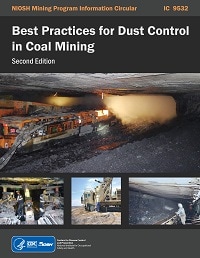Mining Publication: Best Practices for Dust Control in Coal Mining. Second edition.
Original creation date: August 2021
Authors: J Colinet, C Halldin, J Schall
NIOSHTIC2 Number: 20063272
Pittsburgh, PA: U.S. Department of Health and Human Services, Public Health Service, Centers for Disease Control and Prevention, National Institute for Occupational Safety and Health, DHHS (NIOSH) Publication No. 2021-119 (IC 9532), 2021 Aug; :1-164
The extraction, transport, and processing of coal produces respirable-sized dust that can be inhaled by miners and cause disabling and potentially fatal lung diseases known as coal workers’ pneumoconiosis (CWP, commonly called “black lung”) or silicosis. Once contracted, there is no cure for these lung diseases, so prevention is the goal. Since 1970, NIOSH has offered health screenings to underground coal miners to identify CWP in individuals and to track CWP prevalence across the industry. After an initial 30-year downward trend, CWP prevalence has been increasing over the last 20 years.
Coal dust particles larger in size than respirable dust, known as float coal dust, are also produced during mining. Float coal dust settles out of the ventilating air onto the floor, ribs, and roof of underground mining entries. This dust can be lifted back into the air from these surfaces to fuel powerful explosions, which have contributed to numerous fatal mine disasters.
To address these issues, coal mine operators search for and implement control technologies that limit worker exposure to respirable dust and minimize the deposition of float coal dust. The controls discussed in this second edition of this handbook range from long-utilized controls that have developed into industry standards to emerging controls that continue to be researched.
The handbook is divided into six chapters. Chapter 1 discusses the health effects of exposure to respirable coal and silica dust. Chapter 2 discusses respirable dust sampling instruments and sampling methods. Chapters 3, 4, and 5 focus on respirable dust control technologies for longwall mining, continuous mining, and surface mining, respectively. Chapter 6 discusses float coal dust sampling and control technologies.

NIOSHTIC2 Number: 20063272
Pittsburgh, PA: U.S. Department of Health and Human Services, Public Health Service, Centers for Disease Control and Prevention, National Institute for Occupational Safety and Health, DHHS (NIOSH) Publication No. 2021-119 (IC 9532), 2021 Aug; :1-164
- Design of a Water Curtain to Reduce Accumulations of Float Coal Dust in Longwall Returns
- Design, Testing, and Modeling of Environmental Enclosures for Controlling Worker Exposure to Airborne Contaminants
- Dust Control Handbook for Industrial Minerals Mining and Processing. Second edition.
- Examination of a Newly Developed Mobile Dry Scrubber (DS) for Coal Mine Dust Control Applications
- Experimental Study on Foam Coverage on Simulated Longwall Roof
- FAST - Field Analysis of Silica Tool - 1.0.8
- The Impact of Black Lung and a Methodology for Controlling Respirable Dust
- Influence of Continuous Mining Arrangements on Respirable Dust Exposures
- Reducing Float Coal Dust: Field Evaluation of an Inline Auxiliary Fan Scrubber
- Testing a Revised Inlet for the Personal Dust Monitor